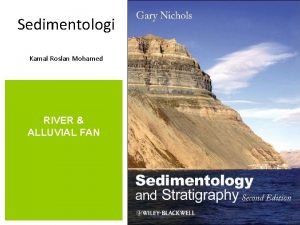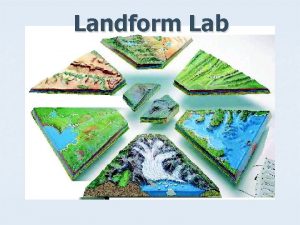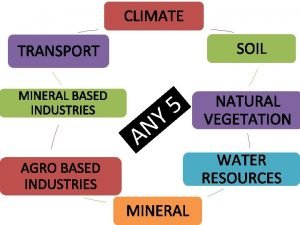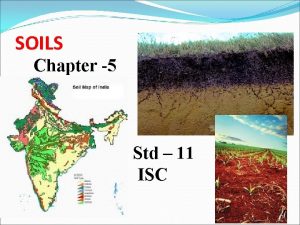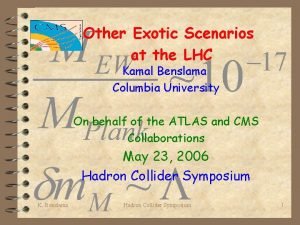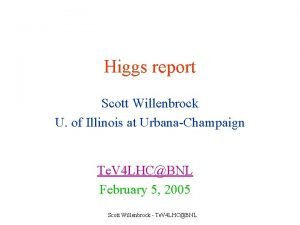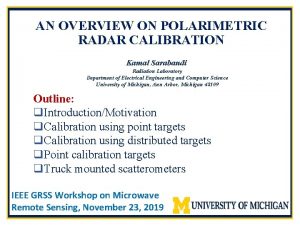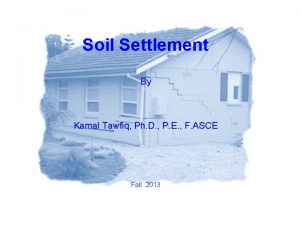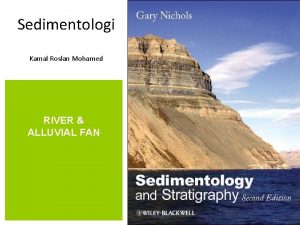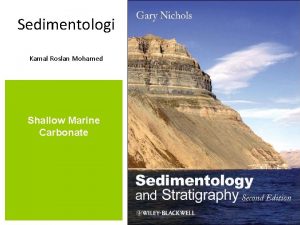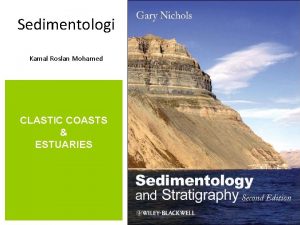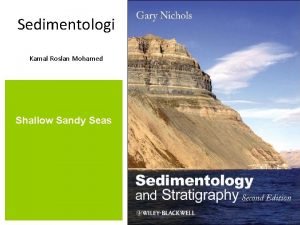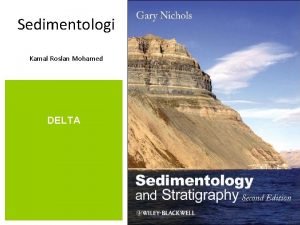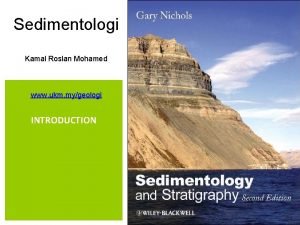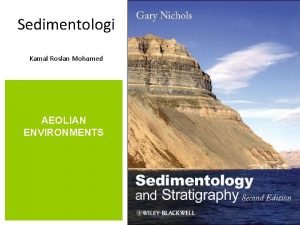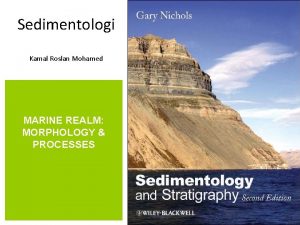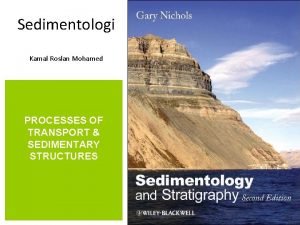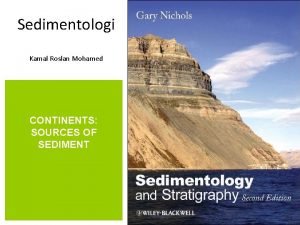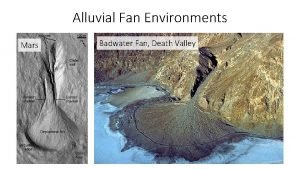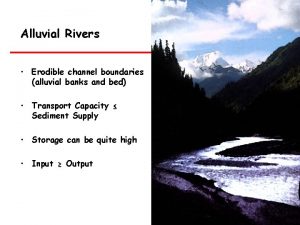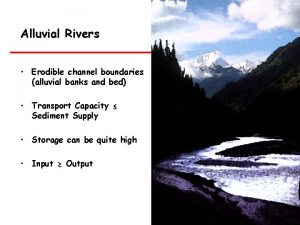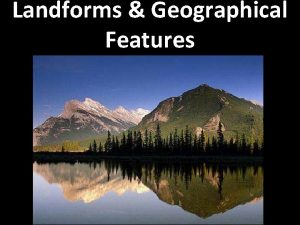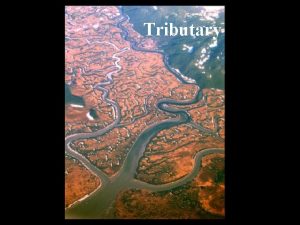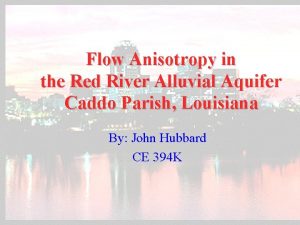Sedimentologi Kamal Roslan Mohamed RIVER ALLUVIAL FAN INTRODUCTION

























- Slides: 25

Sedimentologi Kamal Roslan Mohamed RIVER & ALLUVIAL FAN

INTRODUCTION Three geomorphological zones can be recognised within fluvial and alluvial systems. In the erosional zone the streams are actively downcutting, removing bedrock from the valley floor and from the valley sides via downslope movement of material into the stream bed. In the transfer zone, the gradient is lower, streams and rivers are not actively eroding, but nor is this a site of deposition. The lower part of the system is the depositional zone, where sediment is deposited in the river channels and on the floodplains of a fluvial system or on the surface of an alluvial fan.

INTRODUCTION Rivers are an important feature of most landscapes, acting as the principal mechanism for the transport of weathered debris away from upland areas and carrying it to lakes and seas, where much of the clastic sediment is deposited. River systems can also be depositional, accumulating sediment within channels and on floodplains. The grain size and the sedimentary structures in the river channel deposits are determined by the supply of detritus, the gradient of the river, the total discharge and seasonal variations in flow. Overbank deposition consists mainly of finer-grained sediment, and organic activity on alluvial plains contributes to the formation of soils, which can be recognised in the stratigraphic record as palaeosols. Water flows over the land surface also occur as unconfined sheetfloods and debris flows that form alluvial fans at the edges of alluvial plains.

INTRODUCTION Water flow in rivers and streams is normally confined to channels / alur, which are depressions or scours in the land surface that contain the flow. The overbank /lampau tebing area or floodplain / dataran banjir is the area of land between or beyond the channels that (apart from rain) receives water only when the river is in flood. Together the channel and overbank settings comprise the fluvial environment.

INTRODUCTION Alluvial is a more general term for land surface processes that involve the flow of water. It includes features such as a water-lain fan of detritus (an alluvial fan) that are not necessarily related to rivers. An alluvial plain / dataran aluvial is a general term for a low-relief continental area where sediment is accumulating, which may include the floodplains of individual rivers. The area of ground that supplies water to a river system is the catchment area / kawasan tadahan (sometimes also referred to as the drainage basin).

RIVER FORMS Rivers in the depositional tract can have a variety of forms, with the principal variables being: (a) How straight or sinuous the channel is; (b) the presence or absence of depositonal bars of sand or gravel within the channel; (c) the number of separate channels that are present in a stretch of the river. Several types of river can be distinguished, based on whether the river channel is straight or sinuous (meandering), has one or multiple channels (anastomosing), and has in-channel bars (braided). Combinations of these forms can often occur.

RIVER FORMS A straight channel / sungai lurus without bars is the simplest form but is relatively uncommon. A braided river / sungai berburai contains mid-channel bars that are covered at bank-full flow, in contrast to an anastomosing river, which consists of multiple, interconnected channels that are separated by areas of floodplain. Both braided anastomosing river channels can be sinuous, and sinuous rivers that have depositional bars only on the insides of bends are called meandering / sungai berliku. Several types of river can be distinguished, based on whether the river channel is straight or sinuous (meandering), has one or multiple channels (anastomosing), and has in-channel bars (braided). Combinations of these forms can often occur.

BREADED RIVER / SUNGAI BERBURAI Rivers with a high proportion of sediment carried by rolling and saltation along the channel floor are referred to as bedload rivers. Where the bedload is deposited as bars of sand or gravel in the channel the flow is divided to give the river a braided form. Main morphological features of a braided river. Deposition of sand and/or gravel occurs on midchannel bars.

BREADED RIVER / SUNGAI BERBURAI The bars in a braided river channel are exposed at low flow stages, but are covered when the flow is at bank-full level. Flow is generally strongest between the bars and the coarsest material will be transported and deposited on the channel floor to form an accumulation of larger clasts, or coarse lag. Main morphological features of a braided river. Deposition of sand and/or gravel occurs on midchannel bars.

This large braided river has moved laterally from right to left.

BREADED RIVER / SUNGAI BERBURAI At the base there will be an erosion surface representing the base of the channel and this will be overlain by a basal lag of coarse clasts deposited on the channel floor. As the flow is stronger in the lower part of the channel the subaqueous dunes, and hence the cross-beds, tend to be larger at the bottom of the bar, decreasing in set size upwards. Finer sands or silts on the top of a bar deposit represent the abandonment of the bar when it is no longer actively moving. A schematic graphic sedimentary log of braided river deposits.

BREADED RIVER / SUNGAI BERBURAI The deposits of gravelly braided rivers are characterised by crossbedded conglomerate representing deposition on channel bars. Sandy braided river deposits typically consist of fining-upward successions from a sharp scoured base through beds of trough and planar cross-bedded, laminated and cross-laminated sandstone. A schematic graphic sedimentary log of braided river deposits.

MEANDERING RIVER / SUNGAI BERLIKU In plan view the thalweg in a river is not straight even if the channel banks are straight and parallel: it will follow a sinuous path, moving from side to side along the length of the channel. In any part of the river the bank closest to the thalweg has relatively fast flowing water against it while the opposite bank has slower flowing water alongside. Meanders develop by the erosion of the bank closest to the thalweg, accompanied by deposition on the opposite side of the channel where the flow is sluggish and the bedload can no longer be carried. A sandy river channel and adjacent overbank area: the river is at low-flow stage exposing areas of sand deposited in the channel. Flow in a river follows the sinuous thalweg resulting in erosion of the bank in places.

MEANDERING RIVER / SUNGAI BERLIKU The river flow may also take a short-cut between meander loops when the river floods: this may result in a new section of channel developing, and the longer loop of the meander built becoming abandoned. The abandoned meander loop becomes isolated as an oxbow lake and will remain as an area of standing water until it becomes filled up by deposition from floods and/or choked by vegetation. The deposits of an oxbow lake may be recognised in ancient fluvial sediments as channel fills made up of fine-grained sediment. Depositional architecture of a meandering river: sandstone bodies formed by the lateral migration of the river channel remain isolated when the channel avulses or is cut-off to form an oxbow lake.

MEANDERING RIVER / SUNGAI BERLIKU Meandering rivers transport and deposit a mixture of suspended and bedload (mixed load). The bedload is carried by the flow in the channel, with the coarsest material carried in the deepest parts of the channel. Finer bedload is also carried in shallower parts of the flow and is deposited along the inner bend of a meander loop where friction reduces the flow velocity. Main morphological features of a meandering river. Deposition occurs on the point bar on the inner side of a bend while erosion occurs on the opposite cut bank. Levees form when flood waters rapidly deposit sediment close to the bank and crevasse splays are created when the levee is breached.

MEANDERING RIVER / SUNGAI BERLIKU The deposits of a meander bend have a characteristic profile of coarser material at the base, becoming progressively finergrained up the inner bank. A schematic graphic sedimentary log of meandering river deposits.

ALLUVIAL FANS Alluvial fans are cones of detritus that form at a break in slope at the edge of an alluvial plain. They are formed by deposition from a flow of water and sediment coming from an erosional realm adjacent to the basin.

ALLUVIAL FANS The ‘classic’ modern alluvial fans described from places such as Death Valley in California, USA occur in arid and semiarid environments. However, alluvial fans also form today in much wetter settings, and alluvial fan deposits occurring in the stratigraphic record may have been deposited in a wide range of climatic regimes. Alluvial fans in the Death Valley, USA, a region with a hot, arid climate.

Morphology of alluvial fans Alluvial fans form where there is a distinct break in topography between the high ground of the drainage basin and the flatter sedimentary basin floor. A feeder canyon funnels the drainage to the basin margin: at this point the valley opens out and there is a change in gradient allowing water and sediment to spread out. The flow quickly loses energy and deposits the sediment load. A colluvial fan, a mixture of scree and debris flows in a cold, relatively dry setting in the Arctic.

Processes of deposition on alluvial fans The processes of deposition on an alluvial fan will be determined by the availability of water, the amount and type of sediment being carried from the feeder canyon, and the gradient on the fan surface. Where there is a dense mixture of water and sediment, transport and deposition are by debris flow, a viscous slurry of material that spreads out on the fan surface as a lobe. Debris flows do not travel far and a small, relatively steep, alluvial fan cone is built up if this is the dominant process.

Processes of deposition on alluvial fans With more water available, the mixture of sediment and water is more dilute: deposition will be either by unconfined sheetfloods, or flow will be constrained to channels on the surface. Dilute, water-lain fan deposits form fans with shallower slopes and greater radial extent (around 10 km).

Morphology of alluvial fans A debris flow on an alluvial fan: the onglomerate is poorly sorted, with the larger clasts completely surrounded by a matrix of finer sediment. Sheetflood deposits on an alluvial fan showing well-developed stratification.

Processes of deposition on alluvial fans Schematic sedimentary logs through debris-flow, sheetflood and stream-channel alluvial fan deposits.

Characteristics of fluvial and alluvial fan deposits. lithologies – conglomerate, sandstone and mudstone . mineralogy – variable, often compositionally immature . texture – very poor in debris flows to moderate in river sands . bed geometry – sheets on fans, lens shaped river channel units . sedimentary structures – cross-bedding and lamination in channel deposits . palaeocurrents – indicate direction of flow and depositional slope . fossils – fauna uncommon, plant fossils may be common in floodplain facies . colour – yellow, red and brown due to oxidising conditions . facies associations – alluvial fan deposits may be associated with ephemeral lake and aeolian dunes, rivers

SEKIAN
 Channel bar sungai
Channel bar sungai Electrons flowing
Electrons flowing Fan out cmos
Fan out cmos Are floodplains constructive or destructive
Are floodplains constructive or destructive Alluvial vs fluvial
Alluvial vs fluvial Alluvial soil
Alluvial soil Characteristics of red soil
Characteristics of red soil Alluvial gin
Alluvial gin Kamal sarabandi
Kamal sarabandi Kamal sarabandi
Kamal sarabandi Kamal kumar ips
Kamal kumar ips Kamal benslama
Kamal benslama Larut matang selama map
Larut matang selama map Scott willenbrock
Scott willenbrock Moustapha kamal gueye
Moustapha kamal gueye Kamal sarabandi
Kamal sarabandi Kamal shehadi
Kamal shehadi Jason helmick
Jason helmick How to learn written english by mostafa kamal
How to learn written english by mostafa kamal Dp
Dp Michael kamal
Michael kamal Shirin kamal
Shirin kamal Mount litera zee school books solutions class 3
Mount litera zee school books solutions class 3 Big data analytics raj kamal
Big data analytics raj kamal Ambica international corporation
Ambica international corporation Kamal ke saman nayan
Kamal ke saman nayan
